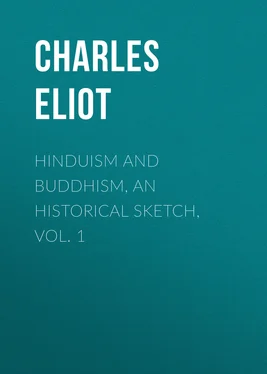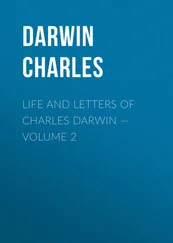Charles Eliot - Hinduism and Buddhism, An Historical Sketch, Vol. 1
Здесь есть возможность читать онлайн «Charles Eliot - Hinduism and Buddhism, An Historical Sketch, Vol. 1» — ознакомительный отрывок электронной книги совершенно бесплатно, а после прочтения отрывка купить полную версию. В некоторых случаях можно слушать аудио, скачать через торрент в формате fb2 и присутствует краткое содержание. Жанр: foreign_religion, Философия, Религиозная литература, foreign_psychology, foreign_antique, foreign_prose, на английском языке. Описание произведения, (предисловие) а так же отзывы посетителей доступны на портале библиотеки ЛибКат.
- Название:Hinduism and Buddhism, An Historical Sketch, Vol. 1
- Автор:
- Жанр:
- Год:неизвестен
- ISBN:нет данных
- Рейтинг книги:5 / 5. Голосов: 1
-
Избранное:Добавить в избранное
- Отзывы:
-
Ваша оценка:
- 100
- 1
- 2
- 3
- 4
- 5
Hinduism and Buddhism, An Historical Sketch, Vol. 1: краткое содержание, описание и аннотация
Предлагаем к чтению аннотацию, описание, краткое содержание или предисловие (зависит от того, что написал сам автор книги «Hinduism and Buddhism, An Historical Sketch, Vol. 1»). Если вы не нашли необходимую информацию о книге — напишите в комментариях, мы постараемся отыскать её.
Hinduism and Buddhism, An Historical Sketch, Vol. 1 — читать онлайн ознакомительный отрывок
Ниже представлен текст книги, разбитый по страницам. Система сохранения места последней прочитанной страницы, позволяет с удобством читать онлайн бесплатно книгу «Hinduism and Buddhism, An Historical Sketch, Vol. 1», без необходимости каждый раз заново искать на чём Вы остановились. Поставьте закладку, и сможете в любой момент перейти на страницу, на которой закончили чтение.
Интервал:
Закладка:
Europeans in discussing such questions as the nature of the soul and immortality are prone to concentrate their attention on death and neglect the phenomena of birth, which surely are equally important. For if a soul survives the death of this complex of cells which is called the body, its origin and development must, according to all analogy, be different from those of the perishable body. Orthodox theology deals with the problem by saying that God creates a new soul every time a child is born 35 35 I believe this to be the orthodox explanation but it is open to many objections. (1) It is a mere phrase. If to create means to produce something out of nothing, then we have never seen such an act and to ascribe a sudden appearance to such an act is really no explanation. Perhaps an act of imagination or a dream may justly be called a creation, but the relation between a soul and its Creator is not usually regarded as similar to the relation between a mind and its fancies. (2) The responsibility of God for the evil of the world seems to be greatly increased, if he is directly responsible for every birth of a child in unhappy conditions. (3) Animals are not supposed to have souls. Therefore the production of an animal's mind is not explained by this theory and it seems to be assumed that such a complex mind ag a dog's can be explained as a function of matter, whereas there is something in a child which cannot be so explained. (4) If a new immortal soul is created every time a birth takes place, the universe must be receiving incalculably large additions. For some philosophies such an idea is impossible. (See Bradley, Appearance and Reality , p. 502. "The universe is incapable of increase. And to suppose a constant supply of new souls, none of which ever perished, would clearly land us in the end in an insuperable difficulty.") But even if we do not admit that it is impossible, it at least destroys all analogy between the material and spiritual worlds. If all the bodies that ever lived continued to exist separately after death, the congestion would be unthinkable. Is a corresponding congestion in the spiritual world really thinkable?
but free discussion usually ignores it and taking an adult as he is, asks what are the chances that any part of him survives death. Yet the questions, what is destroyed at death and how and why, are closely connected with the questions what comes into existence at birth and how and why. This second series of questions is hard enough, but it has this advantage over the first that whereas death abruptly closes the road and we cannot follow the soul one inch on its journey beyond, the portals of birth are a less absolute frontier. We know that every child has passed through stages in which it could hardly be called a child. The earliest phase consists of two cells, which unite and then proceed to subdivide and grow. The mystery of the process by which they assume a human form is not explained by scientific or theological phrases. The complete individual is assuredly not contained in the first germ. The microscope cannot find it there and to say that it is there potentially, merely means that we know the germ will develop in a certain way. To say that a force is manifesting itself in the germ and assuming the shape which it chooses to take or must take is also merely a phrase and metaphor, but it seems to me to fit the facts 36 36 This seems to be the view of the Chândogya Up. VI. 12. As the whole world is a manifestation ol Brahman, so is the great banyan tree a manifestation of the subtle essence which is also present in its minute seeds.
.
The doctrines of pre-existence and transmigration (but not, I think, of karma which is purely Indian) are common among savages in Africa and America, nor is their wide distribution strange. Savages commonly think that the soul wanders during sleep and that a dead man's soul goes somewhere: what more natural than to suppose that the soul of a new born infant comes from somewhere? But among civilized peoples such ideas are in most cases due to Indian influence. In India they seem indigenous to the soil and not imported by the Aryan invaders, for they are not clearly enunciated in the Rig Veda, nor formulated before the time of the Upanishads 37 37 The Brihad Ar. Up. knows of samsâra and karma but as matters of deep philosophy and not for the vulgar: but in the Buddhist Pitakas they are assumed as universally accepted. The doctrine must therefore have been popularized after the composition of the Upanishad. But some allowance must be made for the fact that the Upanishads and the earliest versions of the Buddhist Suttas were produced in different parts of India.
. They were introduced by Buddhism to the Far East and their presence in Manichaeism, Neoplatonism, Sufiism and ultimately in the Jewish Kabbala seems a rivulet from the same source. Recent research discredits the theory that metempsychosis was an important feature in the earlier religion of Egypt or among the Druids 38 38 Yet many instances are quoted from Celtic and Teutonic folklore to the effect that birds and butterflies are human souls, and Caesar's remarks about the Druids may not be wholly wrong.
. But it played a prominent part in the philosophy of Pythagoras and in the Orphic mysteries, which had some connection with Thrace and possibly also with Crete. A few great European intellects 39 39 Several other Europeans of eminence have let their minds play with the ideas of metempsychosis, pre-existence and karma, as for instance Giordano Bruno, Swedenborg, Goethe, Lessing, Lavater, Herder, Schopenhauer, Ibsen, von Helmont, Lichtenberg and in England such different spirits as Hume and Wordsworth. It would appear that towards the end of the eighteenth century these ideas were popular in some literary circles on the continent. See Bertholet, The Transmigration of Souls , pp. 111 ff. Recently Professor McTaggart has argued in favour of the doctrine with great lucidity and persuasiveness. Huxley too did not think it absurd. See his Romanes Lecture, Evolution and Ethics, Collected Essays , vol. IX. p. 61. As Deussen observes, Kant's argument which bases immortality on the realization of the moral law, attainable only by an infinite process of approximation, points to transmigration rather than immortality in the usual sense.
--notably Plato and Virgil—have given it undying expression, but Europeans as a whole have rejected it with that curiously crude contempt which they have shown until recently for Oriental art and literature.
Considering how fixed is the belief in immortality among Europeans, or at least the desire for it, the rarity of a belief in pre-existence or transmigration is remarkable. But most people's expectation of a future life is based on craving rather than on reasoned anticipation. I cannot myself understand how anything that comes into being can be immortal. Such immortality is unsupported by a single analogy nor can any instance be quoted of a thing which is known to have had an origin and yet is even apparently indestructible 40 40 The chemical elements are hardly an exception. Apparently they have no beginning and no end but there is reason to suspect that they have both.
. And is it possible to suppose that the universe is capable of indefinite increase by the continual addition of new and eternal souls? But these difficulties do not exist for theories which regard the soul as something existing before as well as after the body, truly immortal a parte ante as well as a parte post and manifesting itself in temporary homes of human or lower shape. Such theories become very various and fall into many obscurities when they try to define the nature of the soul and its relation to the body, but they avoid what seems to me the contradiction of the created but immortal soul.
Интервал:
Закладка:
Похожие книги на «Hinduism and Buddhism, An Historical Sketch, Vol. 1»
Представляем Вашему вниманию похожие книги на «Hinduism and Buddhism, An Historical Sketch, Vol. 1» списком для выбора. Мы отобрали схожую по названию и смыслу литературу в надежде предоставить читателям больше вариантов отыскать новые, интересные, ещё непрочитанные произведения.
Обсуждение, отзывы о книге «Hinduism and Buddhism, An Historical Sketch, Vol. 1» и просто собственные мнения читателей. Оставьте ваши комментарии, напишите, что Вы думаете о произведении, его смысле или главных героях. Укажите что конкретно понравилось, а что нет, и почему Вы так считаете.












